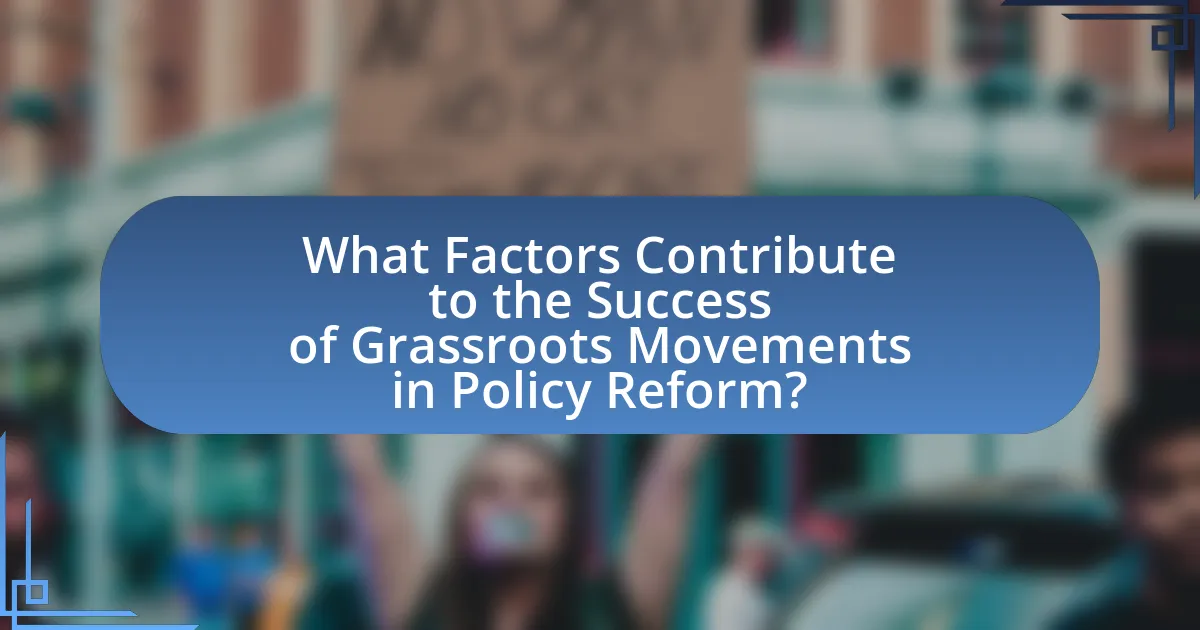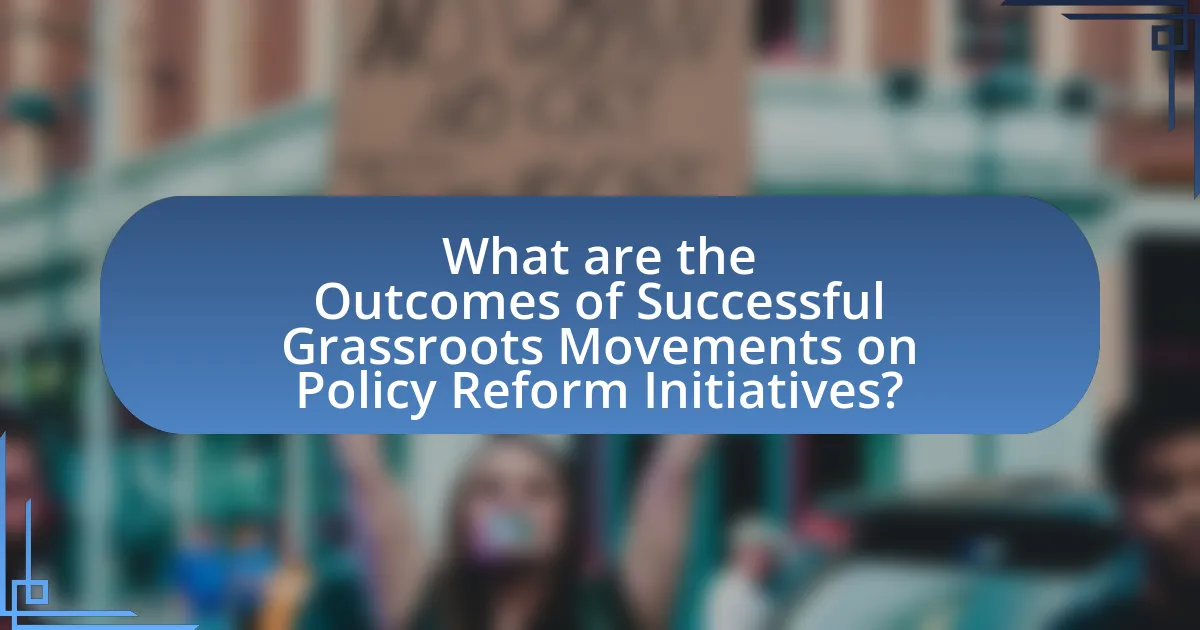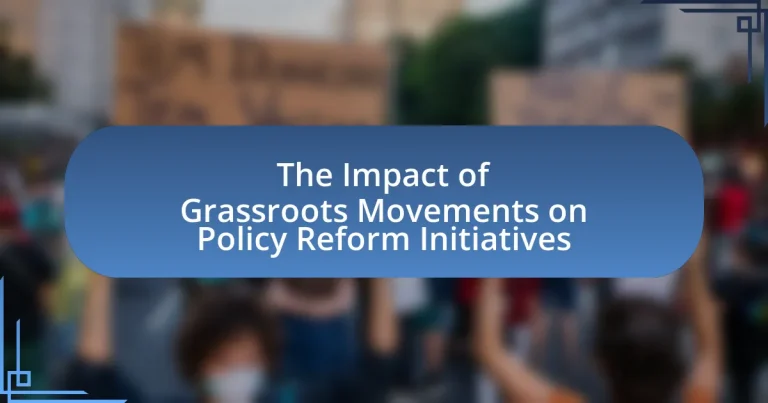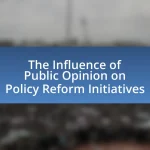Grassroots movements are organized efforts by ordinary individuals aimed at achieving social or political change, often originating from local communities. This article examines the significant role these movements play in policy reform initiatives by mobilizing public support, raising awareness, and influencing decision-makers. It explores various strategies employed by grassroots movements, such as community organizing, advocacy, and coalition-building, while highlighting historical examples like the Civil Rights Movement and the anti-apartheid movement. Additionally, the article discusses the challenges faced by grassroots initiatives, including funding limitations and institutional resistance, and outlines the factors contributing to their success in effecting tangible policy changes.

What are Grassroots Movements and Their Role in Policy Reform Initiatives?
Grassroots movements are organized efforts by ordinary people to effect social or political change, often emerging from local communities. These movements play a crucial role in policy reform initiatives by mobilizing public support, raising awareness about specific issues, and influencing decision-makers. For example, the Civil Rights Movement in the United States, which began at the grassroots level, successfully led to significant legislative changes, including the Civil Rights Act of 1964. This demonstrates how grassroots activism can directly impact policy by creating pressure for reform and fostering a collective voice that policymakers cannot ignore.
How do grassroots movements influence public policy?
Grassroots movements influence public policy by mobilizing community members to advocate for specific issues, thereby creating pressure on policymakers. These movements often utilize strategies such as organizing protests, engaging in lobbying efforts, and leveraging social media to raise awareness and build public support. For instance, the Civil Rights Movement in the 1960s effectively utilized grassroots organizing to push for legislative changes, resulting in the Civil Rights Act of 1964 and the Voting Rights Act of 1965. This historical example illustrates how grassroots efforts can lead to significant policy reforms by amplifying the voices of marginalized communities and compelling government action.
What strategies do grassroots movements employ to effect change?
Grassroots movements employ strategies such as community organizing, advocacy, coalition-building, and direct action to effect change. Community organizing involves mobilizing individuals at the local level to raise awareness and build collective power, as seen in movements like the Civil Rights Movement, which effectively utilized local leaders to galvanize support. Advocacy focuses on influencing policymakers through lobbying and public campaigns, exemplified by organizations like the Sierra Club, which has successfully pushed for environmental legislation. Coalition-building brings together diverse groups to amplify voices and resources, demonstrated by the Women’s March, which united various organizations to advocate for women’s rights. Direct action, including protests and sit-ins, serves to disrupt the status quo and draw media attention, as evidenced by the Occupy Wall Street movement, which highlighted economic inequality. These strategies collectively enhance the effectiveness of grassroots movements in driving policy reform initiatives.
How do grassroots movements mobilize community support?
Grassroots movements mobilize community support by fostering local engagement and building relationships among community members. These movements often utilize strategies such as organizing community meetings, leveraging social media platforms for outreach, and creating coalitions with local organizations to amplify their message. For instance, the Black Lives Matter movement effectively mobilized support through social media campaigns that raised awareness about racial injustice, leading to widespread protests and policy discussions. Additionally, research from the Stanford Social Innovation Review indicates that grassroots movements can increase civic participation by providing a platform for marginalized voices, thereby enhancing community solidarity and collective action.
Why are grassroots movements essential for policy reform?
Grassroots movements are essential for policy reform because they mobilize community engagement and amplify the voices of marginalized groups. These movements often serve as catalysts for change by raising awareness about specific issues, thereby influencing public opinion and policy agendas. For instance, the Civil Rights Movement in the United States effectively utilized grassroots organizing to challenge systemic racism, leading to significant legislative changes such as the Civil Rights Act of 1964. This demonstrates that grassroots efforts can directly impact policy by fostering a collective identity and pushing for accountability from policymakers.
What historical examples illustrate the impact of grassroots movements?
Historical examples that illustrate the impact of grassroots movements include the Civil Rights Movement in the United States and the anti-apartheid movement in South Africa. The Civil Rights Movement, particularly from the 1950s to the 1960s, mobilized citizens to demand equal rights and led to significant legislative changes, such as the Civil Rights Act of 1964 and the Voting Rights Act of 1965. This movement was characterized by grassroots organizing, including protests, sit-ins, and community activism, which effectively pressured the government to address racial discrimination.
Similarly, the anti-apartheid movement in South Africa, which gained momentum in the 1980s, was driven by grassroots activism that united various groups against racial segregation and oppression. This movement culminated in the dismantling of apartheid laws and the election of Nelson Mandela as the first Black president in 1994. The sustained efforts of grassroots organizations, such as the African National Congress and various community groups, played a crucial role in mobilizing international support and influencing policy changes.
Both movements demonstrate how grassroots efforts can lead to significant social and political reforms, showcasing the power of collective action in shaping policy.
How do grassroots movements challenge traditional power structures?
Grassroots movements challenge traditional power structures by mobilizing collective action from local communities to advocate for change, often bypassing established political channels. These movements leverage social media and community organizing to amplify their voices, creating pressure on policymakers and institutions. For instance, the Civil Rights Movement in the United States utilized grassroots organizing to dismantle segregation laws, demonstrating the effectiveness of local activism in influencing national policy. Additionally, the rise of movements like Black Lives Matter illustrates how grassroots efforts can reshape public discourse and demand accountability from authorities, thereby disrupting conventional power dynamics.

What Factors Contribute to the Success of Grassroots Movements in Policy Reform?
The success of grassroots movements in policy reform is primarily influenced by community engagement, effective communication, and strategic alliances. Community engagement fosters a sense of ownership and mobilizes individuals to participate actively, as seen in the Civil Rights Movement, where local involvement was crucial for achieving legislative changes. Effective communication, including the use of social media, allows movements to disseminate their messages widely and rally support, exemplified by the Women’s March in 2017, which drew millions globally through coordinated messaging. Strategic alliances with established organizations and influential stakeholders enhance credibility and resource access, as demonstrated by the collaboration between environmental groups and indigenous communities in the fight against climate change policies. These factors collectively create a robust framework for grassroots movements to influence policy reform successfully.
How does community engagement affect grassroots movement outcomes?
Community engagement significantly enhances grassroots movement outcomes by fostering collective action and increasing visibility. When community members actively participate, they contribute diverse perspectives and resources, which strengthens the movement’s legitimacy and effectiveness. Research indicates that movements with high levels of community involvement are more likely to achieve their goals; for instance, the 2011 Occupy Wall Street movement gained momentum through local assemblies that encouraged public participation, leading to widespread awareness of economic inequality. Additionally, studies show that engaged communities can mobilize more effectively, as seen in the successful campaigns for environmental policy reforms, where local advocacy groups leveraged community support to influence legislation.
What role does social media play in grassroots mobilization?
Social media serves as a crucial tool for grassroots mobilization by facilitating communication, organization, and outreach among activists and supporters. It enables grassroots movements to rapidly disseminate information, coordinate events, and engage a wider audience, often leading to increased participation and visibility. For instance, the Arab Spring demonstrated how platforms like Twitter and Facebook were instrumental in organizing protests and sharing real-time updates, which significantly contributed to the movements’ momentum and success. Additionally, studies have shown that social media can amplify messages, allowing grassroots organizations to reach millions, thereby influencing public opinion and policy discussions.
How do alliances with other organizations enhance grassroots efforts?
Alliances with other organizations enhance grassroots efforts by increasing resource access, expanding networks, and amplifying advocacy messages. When grassroots movements collaborate with established organizations, they gain financial support, expertise, and logistical assistance, which can significantly boost their initiatives. For instance, a study by the Stanford Social Innovation Review highlights that partnerships can lead to a 50% increase in outreach effectiveness, as organizations share their platforms and audiences. This collaboration not only strengthens the grassroots movement’s capacity but also elevates its visibility and influence in policy discussions, ultimately driving more substantial reform initiatives.
What challenges do grassroots movements face in policy reform?
Grassroots movements face significant challenges in policy reform, primarily due to limited resources, lack of political influence, and institutional resistance. Limited financial and human resources hinder their ability to mobilize effectively and sustain campaigns. For instance, a study by the National Democratic Institute found that grassroots organizations often struggle to compete with well-funded lobbyists and established interest groups, which can dominate the policy-making process. Additionally, grassroots movements frequently encounter resistance from political institutions that may view their demands as disruptive or radical, leading to pushback against proposed reforms. This institutional resistance can manifest in bureaucratic hurdles or outright opposition from policymakers. Furthermore, grassroots movements often face difficulties in achieving broad public support, which is crucial for influencing policy change, as evidenced by the challenges faced by movements like Occupy Wall Street in translating their message into concrete legislative action.
How do funding and resource limitations impact grassroots initiatives?
Funding and resource limitations significantly hinder grassroots initiatives by restricting their operational capacity and outreach. These limitations often result in reduced staffing, inadequate materials, and insufficient marketing efforts, which can stifle the initiative’s ability to mobilize community support and influence policy effectively. For instance, a study by the National Committee for Responsive Philanthropy found that organizations with limited funding are less likely to engage in advocacy efforts, which are crucial for driving policy reform. Consequently, grassroots movements may struggle to sustain momentum, leading to diminished impact on the intended policy changes.
What legal and political obstacles do grassroots movements encounter?
Grassroots movements encounter significant legal and political obstacles, including restrictive laws, lack of access to political processes, and opposition from established power structures. For instance, many jurisdictions impose stringent regulations on fundraising and campaigning that can limit grassroots organizations’ ability to mobilize resources effectively. Additionally, grassroots movements often face challenges in gaining recognition and legitimacy within political systems that favor established parties, making it difficult to influence policy. Research indicates that in the United States, for example, the Citizens United v. FEC decision has allowed for increased corporate influence in politics, which can marginalize grassroots efforts. Furthermore, grassroots movements may encounter pushback from local governments or law enforcement, as seen in protests against environmental policies, where authorities may impose permits or restrictions that hinder their activities.

What are the Outcomes of Successful Grassroots Movements on Policy Reform Initiatives?
Successful grassroots movements lead to significant policy reform initiatives by mobilizing public support, influencing legislators, and creating awareness around specific issues. For instance, the Civil Rights Movement in the United States resulted in landmark legislation such as the Civil Rights Act of 1964 and the Voting Rights Act of 1965, which were direct outcomes of sustained grassroots activism. Additionally, the environmental movement has led to the establishment of policies like the Clean Air Act and the Clean Water Act, demonstrating how organized community efforts can shape legislative agendas. These movements often leverage social media and community organizing to amplify their messages, resulting in increased political engagement and accountability from elected officials.
How do grassroots movements achieve tangible policy changes?
Grassroots movements achieve tangible policy changes through organized collective action that mobilizes community support and influences decision-makers. These movements often utilize strategies such as advocacy campaigns, public demonstrations, and social media outreach to raise awareness and build momentum around specific issues. For instance, the Civil Rights Movement in the United States effectively utilized protests and legal challenges to dismantle segregation laws, resulting in the Civil Rights Act of 1964. Additionally, grassroots movements often engage in lobbying efforts, directly interacting with legislators to advocate for policy reforms, as seen in the environmental movement’s push for climate legislation. By leveraging public sentiment and demonstrating widespread support, grassroots movements can compel policymakers to respond to their demands, leading to significant legislative changes.
What metrics can be used to measure the success of grassroots movements?
Metrics used to measure the success of grassroots movements include participation rates, policy changes, media coverage, and community engagement. Participation rates reflect the number of individuals involved in the movement, indicating its reach and mobilization effectiveness. Policy changes serve as a direct measure of impact, showcasing whether the movement has influenced legislation or regulations. Media coverage quantifies public awareness and the movement’s visibility, often correlating with its influence on public opinion. Community engagement metrics, such as volunteer hours and local partnerships, demonstrate the movement’s ability to foster sustained involvement and support within the community. These metrics collectively provide a comprehensive assessment of a grassroots movement’s effectiveness in achieving its goals.
How do successful grassroots movements influence future policy initiatives?
Successful grassroots movements influence future policy initiatives by mobilizing public support and shaping political discourse. These movements often raise awareness about specific issues, leading to increased public engagement and pressure on policymakers. For example, the Civil Rights Movement in the United States successfully advocated for legislative changes, such as the Civil Rights Act of 1964, by organizing protests and fostering community solidarity, which compelled lawmakers to address racial inequality. Additionally, grassroots movements can create a framework for policy proposals that reflect the needs and desires of the community, as seen in the environmental movement’s push for climate legislation, which has led to significant policy shifts at local, state, and national levels.
What lessons can be learned from grassroots movements in policy reform?
Grassroots movements in policy reform demonstrate the importance of community engagement and collective action in driving change. These movements often mobilize individuals around shared issues, leading to increased awareness and advocacy that can influence policymakers. For instance, the Civil Rights Movement in the United States effectively utilized grassroots organizing to challenge systemic racism, resulting in landmark legislation such as the Civil Rights Act of 1964. This illustrates that grassroots efforts can create significant political pressure, leading to tangible policy outcomes. Additionally, grassroots movements highlight the necessity of building coalitions and fostering inclusive participation, which can enhance the legitimacy and effectiveness of reform initiatives.
What best practices can grassroots movements adopt for greater impact?
Grassroots movements can adopt several best practices for greater impact, including building strong coalitions, leveraging social media for outreach, and engaging in strategic advocacy. Strong coalitions enhance collective power, as evidenced by the success of the Women’s March, which united diverse groups to amplify their voices. Leveraging social media allows movements to reach wider audiences quickly; for instance, the #BlackLivesMatter movement effectively utilized platforms like Twitter to mobilize support and raise awareness. Engaging in strategic advocacy, such as targeted lobbying and policy proposals, can lead to tangible policy changes, as seen in the successful campaigns for climate action led by grassroots organizations. These practices collectively enhance the effectiveness and reach of grassroots movements in influencing policy reform initiatives.
How can grassroots movements sustain momentum after achieving policy changes?
Grassroots movements can sustain momentum after achieving policy changes by maintaining active engagement with their supporters and continuously advocating for further reforms. This involves organizing follow-up campaigns, leveraging social media for ongoing communication, and creating coalitions with other organizations to amplify their message. For instance, the Women’s March, which began as a response to the 2016 U.S. presidential election, has successfully mobilized millions for various causes by consistently addressing issues like reproductive rights and racial justice, demonstrating that sustained advocacy can keep the movement alive and relevant. Additionally, research indicates that movements that establish clear goals and maintain a visible presence in public discourse are more likely to retain their influence over time.
What practical steps can individuals take to support grassroots movements?
Individuals can support grassroots movements by actively participating in local initiatives, donating to organizations, and spreading awareness through social media. Engaging in local initiatives, such as attending meetings or volunteering, helps build community and strengthens the movement’s impact. Financial contributions to grassroots organizations enable them to sustain their efforts and expand their reach. Additionally, sharing information and updates on social media platforms can amplify the movement’s message, reaching a broader audience and encouraging more people to get involved. Research shows that grassroots movements can significantly influence policy reform, as seen in the success of movements like Black Lives Matter, which has led to legislative changes in various jurisdictions.


